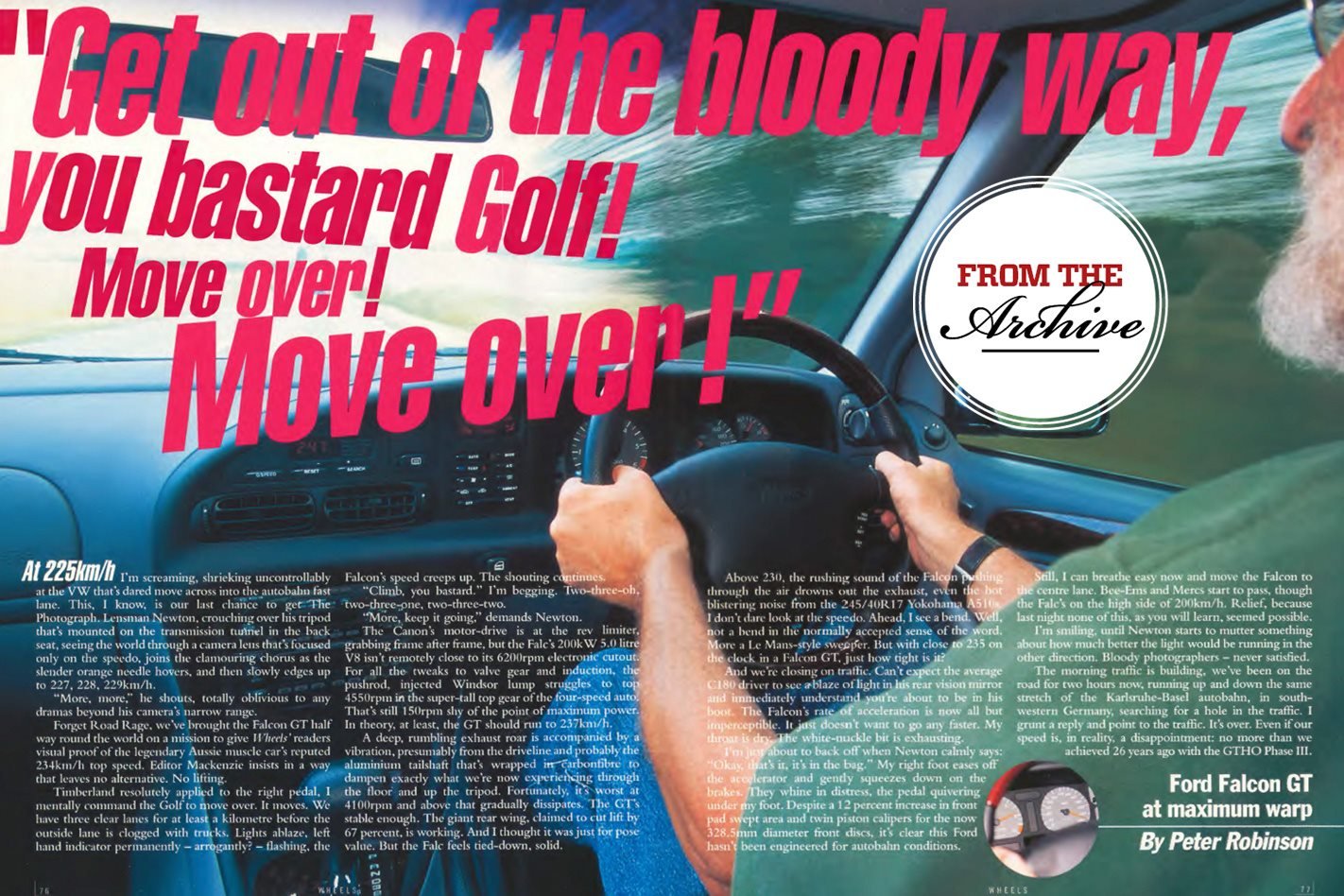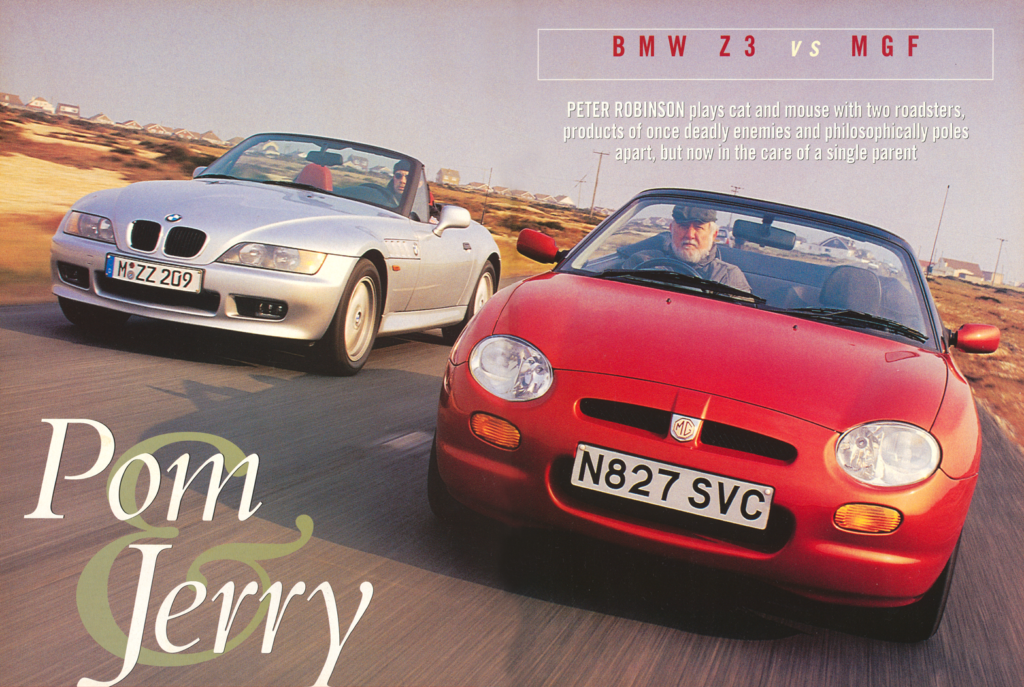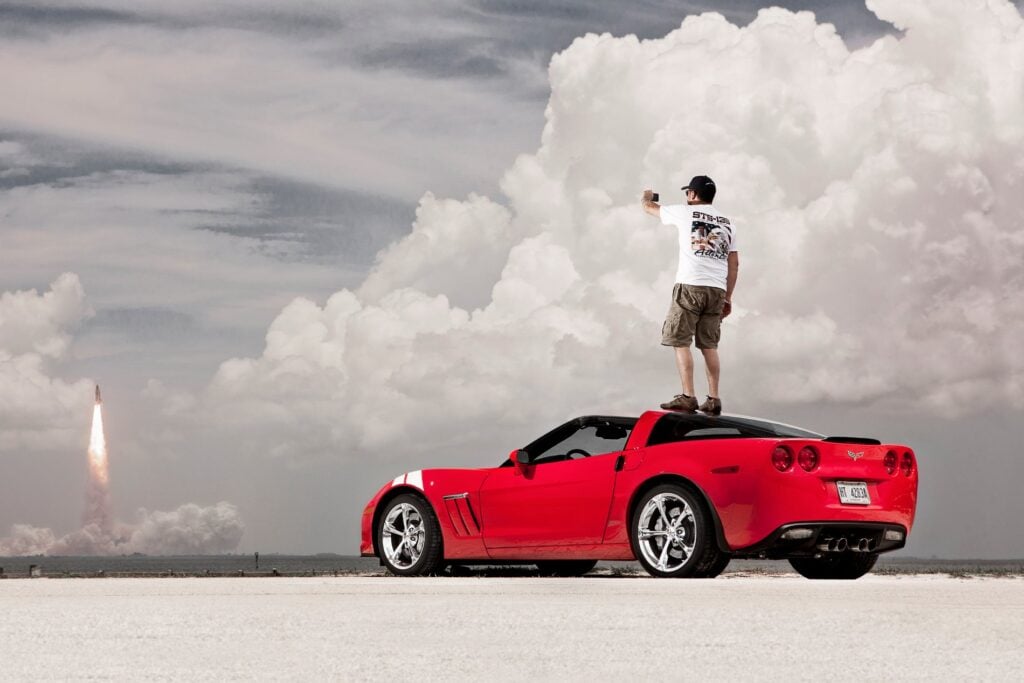Peter Robinson’s attempt to take the Ford Falcon EL GT to maximum warp on the Autobahn.
First published in the January 1998 issue of Wheels magazine, Australia’s most experienced and most trusted car magazine since 1953.
“Get out of the bloody way, you bastard Golf! Move over! MOVE OVER!”
At 225km/h I’m screaming, shrieking uncontrollably at the VW that’s dared move across into the autobahn fast lane. This, I know, is our last chance to get The Photograph. Lensman Newton, crouching over his tripod that’s mounted on the transmission tunnel in the back seat, seeing the world through a camera lens that’s focused only on the speedo, joins the clamouring chorus as the slender orange needle hovers, and then slowly edges up to 227, 228, 229km/h.
“More, more,” he shouts, totally oblivious to any dramas beyond his camera’s narrow range.
Forget Road Rage, we’ve brought the Falcon GT half way round the world on a mission to give Wheels’ readers visual proof of the legendary Aussie muscle car’s reputed 234km/h top speed. Editor Mackenzie insists in a way that leaves no alternative. No lifting.
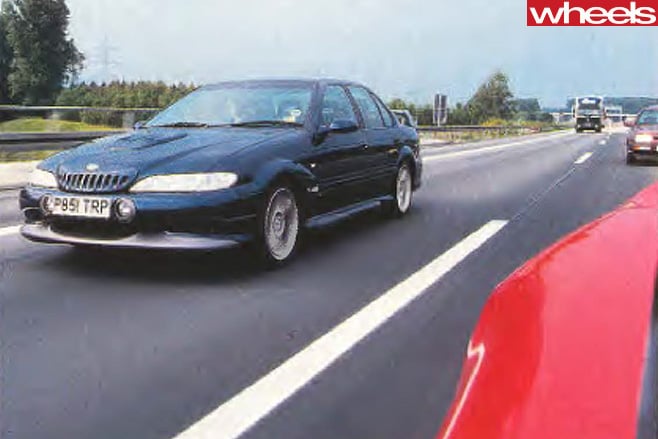
“Climb, you bastard” I’m begging. Two-three-oh, two-three-one, two-three-two.
“More, keep it going,” demands Newton.
The Canon’s motor-drive is at the rev limiter, grabbing frame after frame, but the Falc’s 200kW 5.0 litre V8 isn’t remotely close to its 6200rpm electronic cutout. For all the tweaks to valve gear and induction, the pushrod injected Windsor lump struggles to top 4550rpm in the super-tall top gear of the four-speed auto. That’s still 150rpm shy of the point of maximum power. In theory, at least, the GT should run to 237km/h.
A deep, rumbling exhaust roar is accompanied by a vibration, presumably from the driveline and probably the aluminium tailshaft that’s wrapped in carbonfibre to dampen exactly what we’re now experiencing through the floor and up the tripod. Fortunately, it’s worst at 4100rpm and above that gradually dissipates. The GT’s stable enough. The giant rear wing, claimed to cut lift by 67 percent, is working. And I thought it was just for pose value. But the Falc feels tied-down, solid.
Above 230, the rushing sound of the Falcon pushing through the air drowns out the exhaust, even the hot blistering noise from the 245/40R17 Yokohama A510s. I don’t dare look at the speedo. Ahead, I see a bend. Well, not a bend in the normally accepted sense of the word. More a Le Mans-style sweeper. But with close to 235 on the clock in a Falcon GT, just how tight is it?
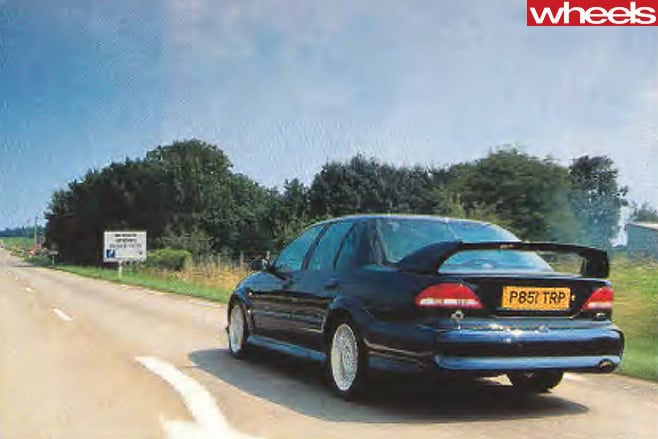
I’m just about to back off when Newton calmly says: “Okay, that’s it, it’s in the bag.” My right foot eases off the accelerator and gently squeezes down on the brakes. They whine in distress, the pedal quivering under my foot. Despite a 12 percent increase in front pad swept area and twin piston callipers or the now 328.5mm diameter front discs, it’s clear this Ford hasn’t been engineered for autobahn conditions.
Still, I can breathe easy now and move the Falcon to the centre lane. Bee-ems and Mercs start to pass, though the Falc’s on the high side of 200km/h. Relief, because last night none of this, as you will learn, seemed possible.
I’m smiling, until Newton starts to mutter something about how much better the light would be running in the other direction. Bloody photographers – never satisfied.
The morning traffic is building, we’ve been on the road for two hours now, running up and down the same stretch of the Karlsruhe-Basel autobahn, in south-western Germany, searching for a hole in the traffic. I grunt a reply and point to the traffic. It’s over. Even if our speed is, in reality, a disappointment: no more than we achieved 26 years ago with the GTHO Phase III.
It’s still legal to drive 250km/h in Germany, even 300km/h if your wheels are an F1 McLaren. Don’t talk to me about the morality of driving at such warp-speeds. In the right conditions and the right car, a 200km/h-plus cruising speed is effortless. Safe. Just ask John Singleton.
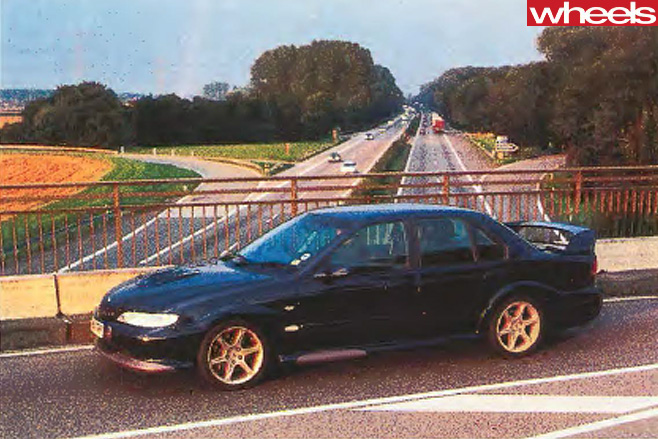
Our plan was simple. We wanted to see how the GT performed on unrestricted autobahns. For the hell of it. You would, wouldn’t you?
It didn’t begin well. The Falcon arrived late. So late we’d given up and decided to abort the story and cancel the photographer. When the navy-blue Falcon GT finally appeared, the delivery driver talked about heavy traffic and torrential rain. Who knows. I suspect he enjoyed a unique driving encounter.
We meet at 6am in an outer London suburb: Richard Newton, my wife Erica, charged with responsibility for the camera car, and your scribe. Camera car? We needed something fast, quick enough to be capable of tailing the GT easily, a car worthy of a pairing for a pan-European drive in the company of Australia’s most charismatic machine. Since Maranello insisted we return the F1 by stumps on Friday night there seemed no alternative but to use it. Ninety minutes later we’re waiting, line astern, Falcon in front, for the ferry in Dover.
Bloke enters scene from behind, ignores the F355, zeros in on the Falcon. He’s seen the wing and wants to know more, aware it’s a Ford and somehow embarrassed he can’t identify it. His son arrives and I let them in on the secret.
“See,” he says to the teenager, “they do make more than Fosters, then.”
Scene two: P&O ticket office. Pom official asks, “What is that beast?” He’s told and shakes his head in disbelief, “Why can’t we have them? I like the nose!”
I can’t believe he means it. The grille is a bizarre collection of shapes as ugly as anything you’d find at the last Tokyo show. But he loves it.
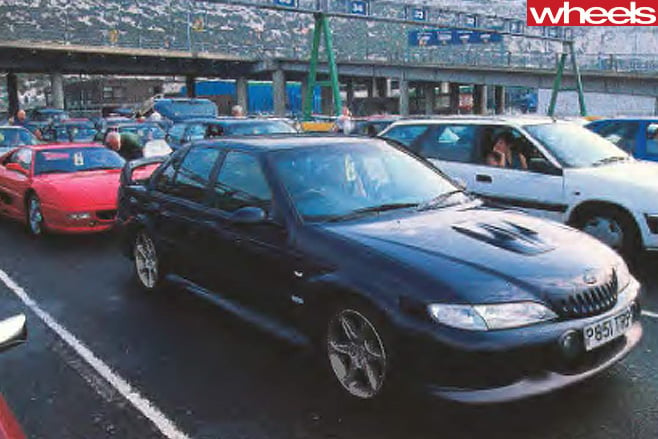
France beckons and our twosome is soon drifting towards Reims at 140km/h, aware that the posted speed limit on autoroutes is 130. We’re being passed by ancient and rusty Renault 5s, knowing that if anything is going to attract the attention of the gendarmes, it’s the tandem combination of scarlet Ferrari and navy-blue Batmobile.
The Falcon isn’t what I expected. The flamboyant exterior predicts raw, almost crude, driving manners, but the Falcon’s refinement as it cruises at little more than an idle, with just 2800rpm on the tacho, is exceptional. Only a mild burble from the exhaust lets you in on the creator’s performance intent. Yet, at the same time, it never feels especially quick. There’s a contradiction here I don’t pretend to understand.
According to the trip computer, the range at these speeds on a constant throttle is 500km. From a comparatively small 68 litre tank, that’s astounding and surely only possible because of the 50.5km/h per 1000rpm gearing in top. The range, we learn later, drops to a puny 260km at top speed. The GT, even in speed-limited Australia, deserves a bigger tank.
The auto, too, comes as a surprise. It shouldn’t; most GTs come this way and I remember the 1968 XT auto as easily the best Australian car of its era. I’m sitting in a sea of leather, Alcantara (an excellent imitation suede first used by Lancia in the ’80s) and fake wood, on a huge bucket seat that feels so comfortable it belongs in somebody’s den. Yet, paradoxically in view of the price and equipment level, seat adjustment is manual and not electric. The wheel is also a mix of leather and (real?) wood, which I hate.
At low speeds there is more weight to the steering than in the Ferrari, which is now perfectly positioned in my rear vision mirror midway between the bottom of the wing and the boot, and I know its tyres aren’t producing the same constant reverberation. The driving position, helped by a wheel that’s lovely to hold at the quarter-to-three position and adjustable every which way and the pedal-wheel relationship, is near perfect.
It’s raining now and the rear tyres are noisily spitting the water against the arches. On those rare occasions when the auto’s asked to shift it feels slightly lumpy, the kickdown inconsistent in its behaviour. Time to depart the autoroute and find some proper roads.
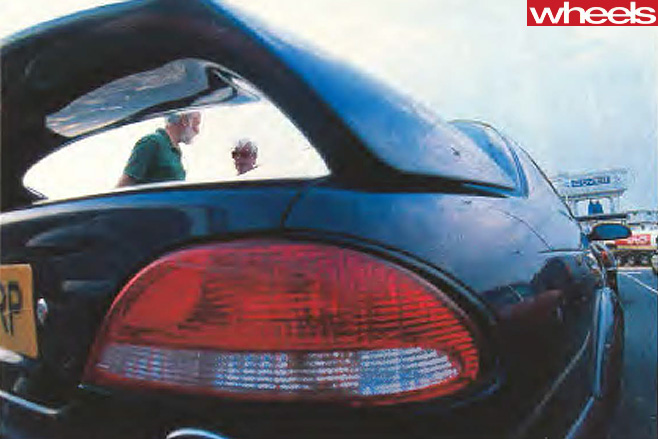
Motoring doesn’t get much better than this: wafting down tree-lined French roads across rolling countryside in a GT Falcon, sun glinting from the wing, the Ferrari steadfastly in the rear vision mirror. We filled both steeds in Verdun, the scene of some of WWI’s most horrific battles. The result: Ferrari 16.1 L/100km (17.5mpg), Falcon 14.4 (19.6). Predictable.
Back to the autoroute. Erica has remembered a hotel in France (for the food) just across the Rhine from the autobahn nominated for our top speed runs. Newton and I figure to go out before dinner, fill the Falcon, and get the photography out of the way after the peak hour traffic has dissipated. Except, after booking in, the Falcon won’t start. The battery is dead. No jumper leads, no push-start. We depart in the Ferrari in search of a new battery.
By 8pm Germany and France have shut like a clam. Nobody, it seems, does anything except sell petrol. A bloke in a 24-hour garage tells us of a place in Baden-Baden that does electrical repairs round the clock. It’s too late for photography, we’re tired and hungry and only continue because neither of us wants to be the one who suggests giving up until tomorrow- when we know the autobahn will be too busy for serious motoring by the time we get the Falcon repaired.
Eventually, unable to find the garage, we meet an enthusiast who not only knows the place but offers to take us. The battery is rooted, the only compatible one is too big. We jam it in and promise to come back tomorrow. We get to bed after midnight and rise at five, desperate to beat the traffic. The Falcon starts and the rest, as they say, is history.
PS: Maranello is beyond my home in Northern Italy – coming from France – so we unpacked the Ferrari on the way. Alone for the last time in the F355, I decided to duplicate the Falcon’s top speed run. To put things into perspective, you understand.
Only from 285km/h does the Ferrari’s acceleration begin to slow and, even so, 300km/h is easier to achieve in the F355 than 230km/h is in the Falcon GT.

